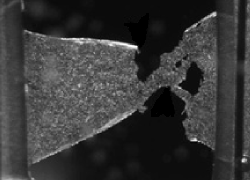
Citation
J. Duque, A. Bonfanti, J. Fouchard, E. Ferber, A. Harris, A.J. Kabla, G.T. Charras
Preprint (2023)
Abstract
Abstract
The ability of tissues to sustain mechanical stress and avoid fracture is a fundamental pillar of their function. Fracture in response to physiological levels of stress can be undesired, for example resulting from disease or genetic mutations, or be an integral part of developmental processes, such as during blastocoel formation in mouse or during leg eversion in flies. Despite its importance, we know very little about fracture in cellularised tissues because it is a multi-scale process that necessitates comprehension of the interplay between mechanical forces and processes at the molecular and cellular scales. Using a combination of mechanical measurements, live imaging and computational modelling, we characterise fracture in epithelial monolayers. We show that, despite consisting of only a single layer of cells, monolayers can withstand surprisingly large deformations, often accommodating several-fold increases in their length before rupture. To protect against large deformation, epithelia increase their stiffness multiple-fold in a process controlled by keratin intermediate filaments. Perturbing keratin organisation fragilised monolayers and prevented strain stiffening. Using computational approaches, we show that, although the kinetics of bond rupture ultimately control fracture, tissue rheology and the history of deformation prior to failure set the strain and stress that the tissue reaches at the onset of fracture. Our data paint a picture of epithelia as versatile materials that combine resistance to shocks with deformability when subjected to low strain rates.
Figure sample


